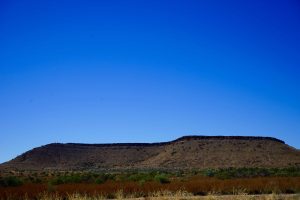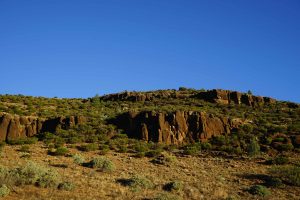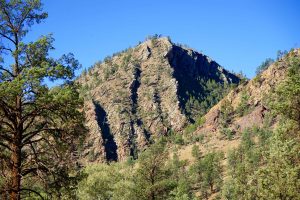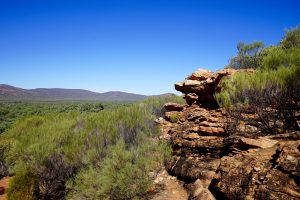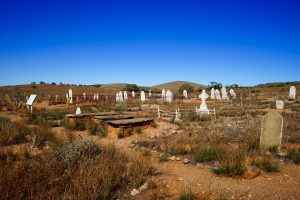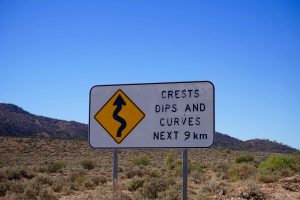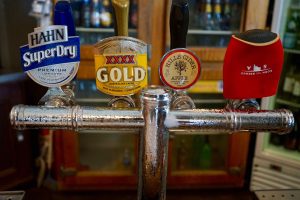Our first venture into the Outback was spectacular! 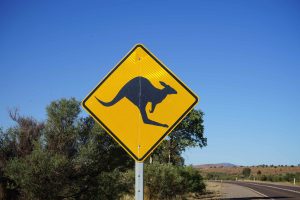
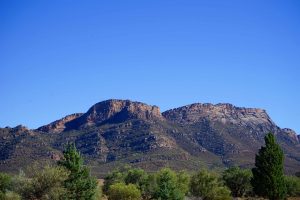 Less than 30 minutes after leaving Adelaide we were into the sparsely populated area of South Australia, passing through a couple very small towns, with one of the largest having a “recorded” population of 490. The eucalyptus and gum trees give it the look of a savanna, at other times the red sparse landscape give it the look of the Arizona desert.
Less than 30 minutes after leaving Adelaide we were into the sparsely populated area of South Australia, passing through a couple very small towns, with one of the largest having a “recorded” population of 490. The eucalyptus and gum trees give it the look of a savanna, at other times the red sparse landscape give it the look of the Arizona desert.
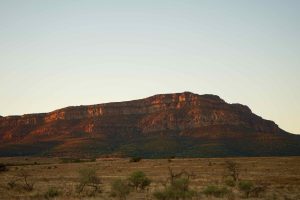
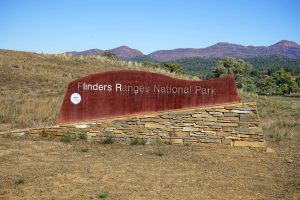 We arrived late afternoon at the Rawnsley Park Station, just outside the Flinders Ranges National Park. The Flinders Ranges are the largest mountain range in South Australia. It was here that in 1946 that the oldest fossil evidence of animal life was discovered, dating back over 500 million years ago. In 2004 a new geological period, the Ediacaran Period was formed to mark the appearance of Ediacara biota. Cave paintings, rock engravings and other artifacts indicate that people have lived in the Flinders Ranges for tens of thousands of years.
We arrived late afternoon at the Rawnsley Park Station, just outside the Flinders Ranges National Park. The Flinders Ranges are the largest mountain range in South Australia. It was here that in 1946 that the oldest fossil evidence of animal life was discovered, dating back over 500 million years ago. In 2004 a new geological period, the Ediacaran Period was formed to mark the appearance of Ediacara biota. Cave paintings, rock engravings and other artifacts indicate that people have lived in the Flinders Ranges for tens of thousands of years.
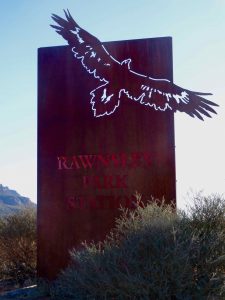
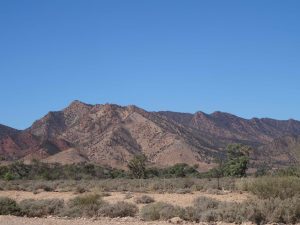 Rawnsley Park Station was named such because of its proximity to Rawnsley Bluff. It was formed in 1851 and initially farmed in hopes of turning this area once labeled as wastelands into productive farming. This was less than succesful and use of this land at the southern end of the Wilpena Pound turned to sheep farming. The cabins at the station were our home for two nights.
Rawnsley Park Station was named such because of its proximity to Rawnsley Bluff. It was formed in 1851 and initially farmed in hopes of turning this area once labeled as wastelands into productive farming. This was less than succesful and use of this land at the southern end of the Wilpena Pound turned to sheep farming. The cabins at the station were our home for two nights.
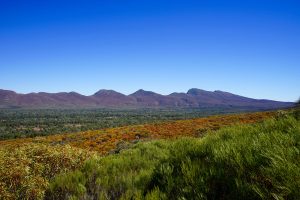
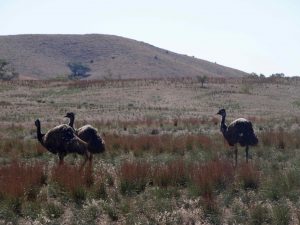 Our first full day we decided to hike the Wilpena Pound to one of the area’s lookouts. On the hike we saw our first live kangaroo and emu (a lot of kangaroo roadkill, similar to the deer problem we see in the US). The emu of course reminded me of my nephew Nicholas who as a toddler had lived briefly in Australia and loved to do his “walk like an emu” imitation…sort of a strutting head bobbing style!
Our first full day we decided to hike the Wilpena Pound to one of the area’s lookouts. On the hike we saw our first live kangaroo and emu (a lot of kangaroo roadkill, similar to the deer problem we see in the US). The emu of course reminded me of my nephew Nicholas who as a toddler had lived briefly in Australia and loved to do his “walk like an emu” imitation…sort of a strutting head bobbing style!
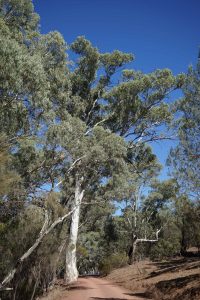
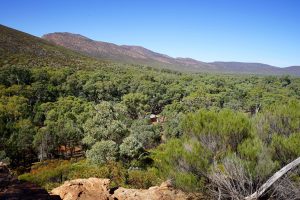 The three hour hike was fairly flat with one steeper ascent up to the lookout. We came across a cabin that had been redone around 1900 but used in the 1800s. The cabin tells an interesting story of how people tried to make a go of it in this challenging outback environment…trying to irrigate small gardens from a stream that occasionally has water or working on building a road for years that was then washed out by one heavy rain. The dry creek beds and apparently a couple of waterfalls fill quickly with rain, making many parts of the area nearly impassable.
The three hour hike was fairly flat with one steeper ascent up to the lookout. We came across a cabin that had been redone around 1900 but used in the 1800s. The cabin tells an interesting story of how people tried to make a go of it in this challenging outback environment…trying to irrigate small gardens from a stream that occasionally has water or working on building a road for years that was then washed out by one heavy rain. The dry creek beds and apparently a couple of waterfalls fill quickly with rain, making many parts of the area nearly impassable.
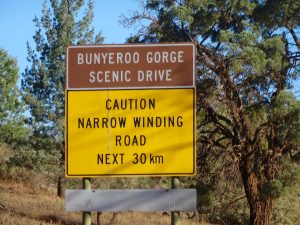
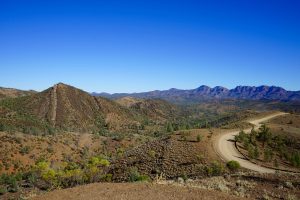
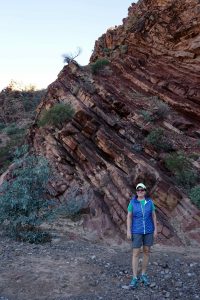 After the hike, we drove through a couple of spectacular gorges on the unsealed dirt roads, Bunyeroo and Brachina Gorges. These gorges contain the fossils over 500 million years old indicating the earth’s first advanced life forms.
After the hike, we drove through a couple of spectacular gorges on the unsealed dirt roads, Bunyeroo and Brachina Gorges. These gorges contain the fossils over 500 million years old indicating the earth’s first advanced life forms.
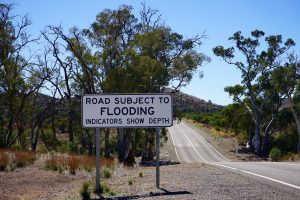
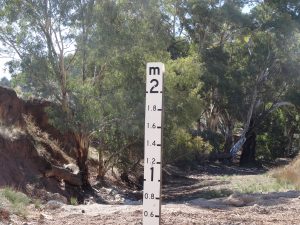 The warning for the road was that it was narrow as well (but not by New Zealand standards!). Many sections of the roads have measuring sticks that alert drivers as to how many meters deep the water is on the road! While we did not see anything but crystal clear blue skies, we did encounter Slippery Dip that had enough water in it to force us to turn around.
The warning for the road was that it was narrow as well (but not by New Zealand standards!). Many sections of the roads have measuring sticks that alert drivers as to how many meters deep the water is on the road! While we did not see anything but crystal clear blue skies, we did encounter Slippery Dip that had enough water in it to force us to turn around. 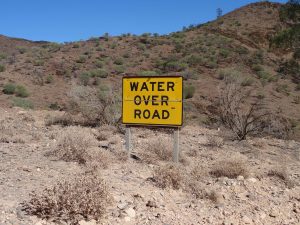
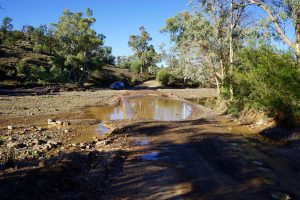 After watching a 4 x 4 pass through the water, it would have been over the threshold of the doors on our little Nissan.
After watching a 4 x 4 pass through the water, it would have been over the threshold of the doors on our little Nissan.
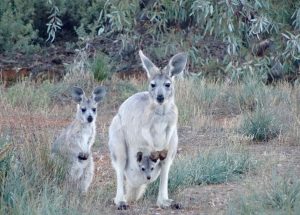
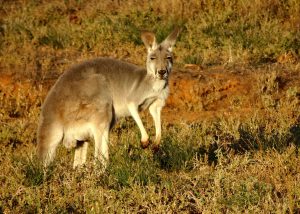
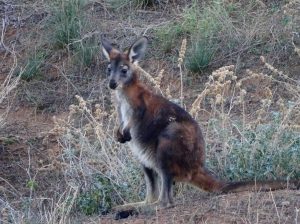 Dusk was nearing so we needed to return to our station. The danger of driving at night on the roads are the numerous kangaroo. Not long after we turned around we were challenged by two kangaroo staring us down in the middle of the road. The roos seemed to multiply as the sun was setting and they were feeding near the roadside. The spectacular sunset was occurring just as we arrived back at our cabin at Rawnsley Station.
Dusk was nearing so we needed to return to our station. The danger of driving at night on the roads are the numerous kangaroo. Not long after we turned around we were challenged by two kangaroo staring us down in the middle of the road. The roos seemed to multiply as the sun was setting and they were feeding near the roadside. The spectacular sunset was occurring just as we arrived back at our cabin at Rawnsley Station.
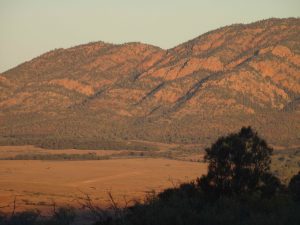
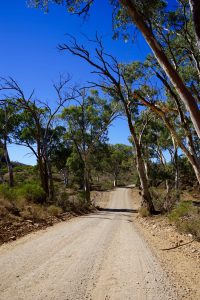
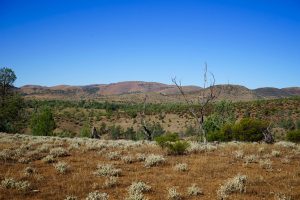 After a nice hot shower to remove the layers of dust acquired while hiking, we headed over to the Woolshed for dinner. We enjoyed a meal and a couple bottles of wine from Barossa and Flinders Ranges with Trudy and Marc, a couple Adelaidians we met the night before dining with Marie and Paul from Melbourne. Wonderful folks and great conversation, great Australia suggestions…hopefully we will see them again in our Australian or other travels!
After a nice hot shower to remove the layers of dust acquired while hiking, we headed over to the Woolshed for dinner. We enjoyed a meal and a couple bottles of wine from Barossa and Flinders Ranges with Trudy and Marc, a couple Adelaidians we met the night before dining with Marie and Paul from Melbourne. Wonderful folks and great conversation, great Australia suggestions…hopefully we will see them again in our Australian or other travels!
The next day in the ranges included a drive north through the park again seeing many different landscapes and more emu and kangaroo! At the northern end of the ranges we turned east at another very small outpost called Blinman, an area known for its copper mining history.
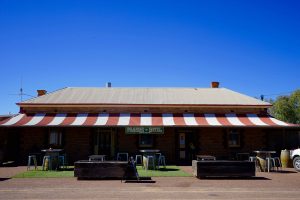
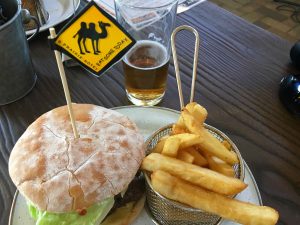
We followed an unsealed road through some beautiful terrain for some 30k to the town of Parachilna (it did have a small building that was labeled a school, a couple old houses and a few abodes that looked more like trailers). There was a old train station and a very old hotel. It was suggested to us by several people to visit the Prairie Hotel in this tiny outback town for a couple of reasons. First, the hotel is renowned for its emu, kangaroo, camel and goat burgers and smoked meats, enjoying some live music and sipping some cold Australian Gold brew. I had the camel burger, a very tasty lean meat but quite moist…not gamey tasting at all.
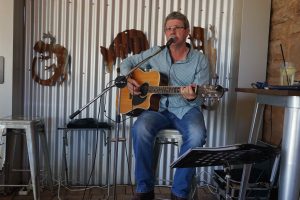
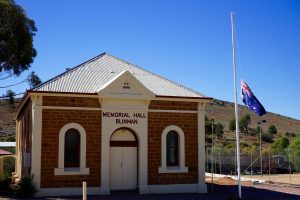 The music was good, a couple guys playing some Australian country or folk, Folsom Prison by Johnny Cash and a couple songs about California, Tennessee and drinking wine. Today was Anzac day, a day to commemorate those that fought in all wars but in particular World War I and the battles in Gallipoli, where Australians and New Zealanders suffered many casualties with a very high percent of death for those sent to fight. The country really does an outstanding job with this commemorative, not glorifying war, but honoring those that have served. Thus, a few songs were well done to honor the brave men and women that sacrificed their lives.
The music was good, a couple guys playing some Australian country or folk, Folsom Prison by Johnny Cash and a couple songs about California, Tennessee and drinking wine. Today was Anzac day, a day to commemorate those that fought in all wars but in particular World War I and the battles in Gallipoli, where Australians and New Zealanders suffered many casualties with a very high percent of death for those sent to fight. The country really does an outstanding job with this commemorative, not glorifying war, but honoring those that have served. Thus, a few songs were well done to honor the brave men and women that sacrificed their lives.
The second reason to visit…the last coal mine in the area is shutting down and the last train is going through this week with the last load of coal. Apparently on this day there was not enough coal…so no train to see!
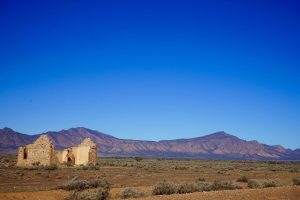
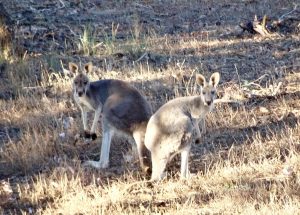 The Flinders Ranges are an awesome place to see, very few people and a lot of kangaroo and emu! Remnants of abandoned homes can be seen dotting the landscape apparently from failed attempts to farm the area in the early 1900s.
The Flinders Ranges are an awesome place to see, very few people and a lot of kangaroo and emu! Remnants of abandoned homes can be seen dotting the landscape apparently from failed attempts to farm the area in the early 1900s.
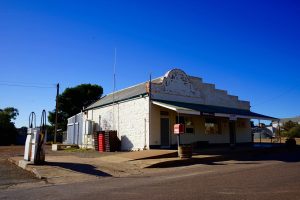
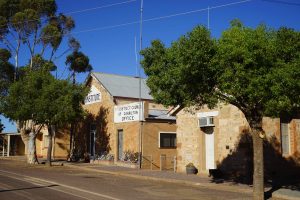 One of the last towns we went through in the south ranges was Carrieton, population 30…when everyone is there :). We didn’t see anyone milling around the few buildings in the town until a lady came outside of the grocery/post office/gas station, put up the “open” sign and made us some coffee. We had a nice conversation with Deborah who told us the town emptied out over the weekend when someone married someone from another town, Quorn, and all the residents traveled to attend.
One of the last towns we went through in the south ranges was Carrieton, population 30…when everyone is there :). We didn’t see anyone milling around the few buildings in the town until a lady came outside of the grocery/post office/gas station, put up the “open” sign and made us some coffee. We had a nice conversation with Deborah who told us the town emptied out over the weekend when someone married someone from another town, Quorn, and all the residents traveled to attend.
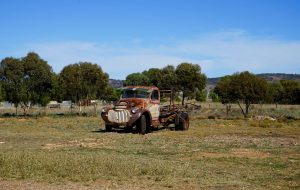
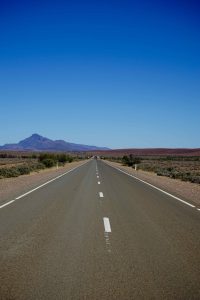 We would love to explore more but there is wine to be tasted…now onto Clare and Barossa Valleys for some winery visits!
We would love to explore more but there is wine to be tasted…now onto Clare and Barossa Valleys for some winery visits!
And a few more pics…
